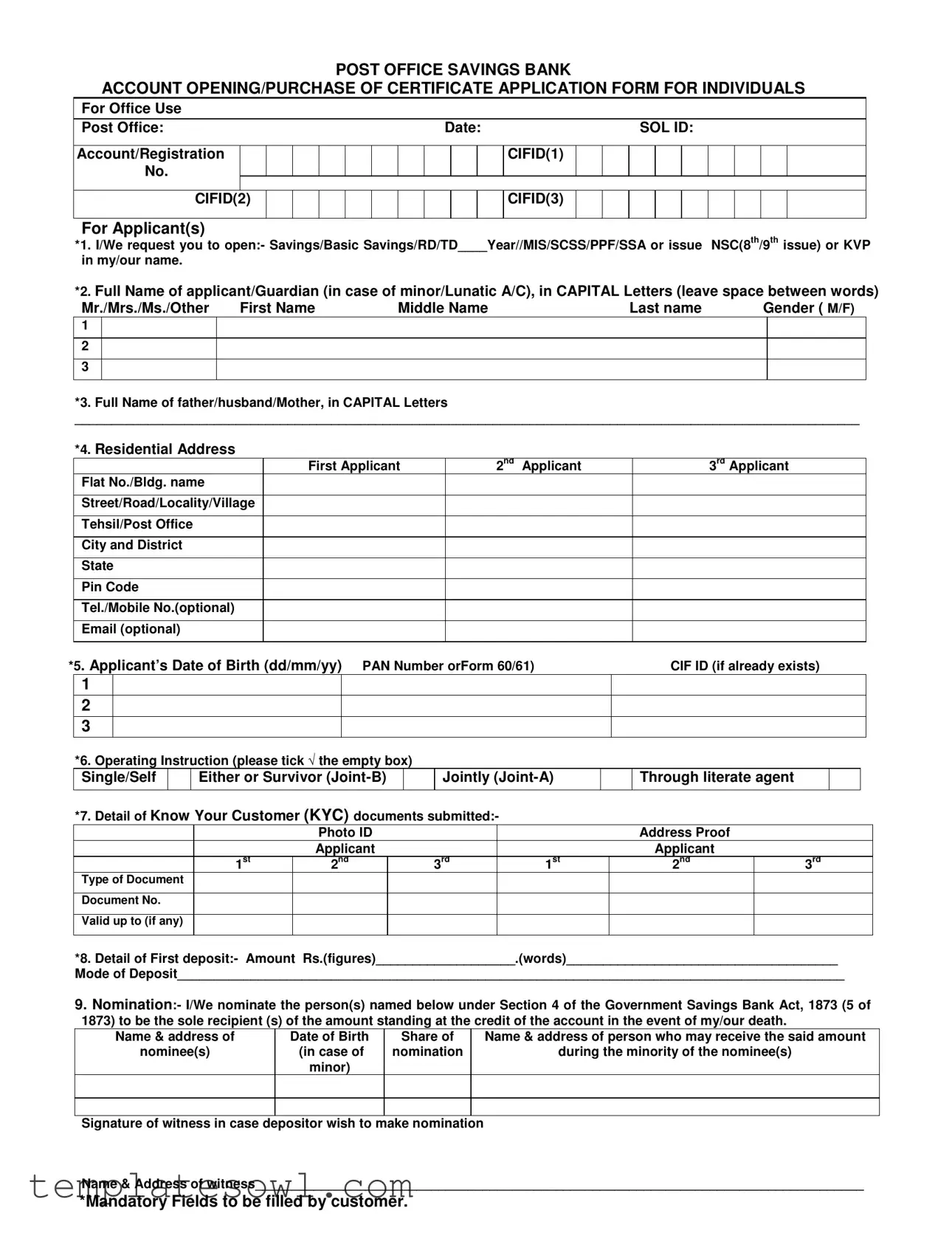
POST OFFICE SAVINGS BANK
ACCOUNT OPENING/PURCHASE OF CERTIFICATE APPLICATION FORM FOR INDIVIDUALS
For Office Use
Post Office: |
|
|
|
|
|
|
Date: |
|
|
|
SOL ID: |
|
|
|
|
|
|
|
|
|
|
|
|
|
|
|
|
|
|
|
|
|
Account/Registration |
|
|
|
|
|
|
|
|
|
|
CIFID(1) |
|
|
|
|
|
|
|
|
|
No. |
|
|
|
|
|
|
|
|
|
|
|
|
|
|
|
|
|
|
|
|
|
|
|
|
|
|
|
|
|
|
|
|
CIFID(2) |
|
|
|
|
|
|
|
|
|
CIFID(3) |
|
|
|
|
|
|
|
|
|
|
|
|
|
|
|
|
|
|
|
|
|
|
|
|
|
|
|
|
|
|
For Applicant(s)
*1. I/We request you to open:- Savings/Basic Savings/RD/TD____Year//MIS/SCSS/PPF/SSA or issue NSC(8th/9th issue) or KVP
in my/our name.
*2. Full Name of applicant/Guardian (in case of minor/Lunatic A/C), in CAPITAL Letters (leave space between words)
Mr./Mrs./Ms./Other |
First Name |
Middle Name |
Last name |
Gender ( M/F) |
1 |
|
|
|
|
|
|
|
|
|
|
|
|
|
2 |
|
|
|
|
|
|
|
|
|
|
|
|
|
3 |
|
|
|
|
|
|
|
|
|
|
|
|
|
*3. Full Name of father/husband/Mother, in CAPITAL Letters
___________________________________________________________________________________________________________
*4. Residential Address
|
|
First Applicant |
2nd Applicant |
3rd Applicant |
|
Flat No./Bldg. name |
|
|
|
|
|
|
|
|
|
Street/Road/Locality/Village |
|
|
|
|
|
|
|
|
|
Tehsil/Post Office |
|
|
|
|
|
|
|
|
|
City and District |
|
|
|
|
|
|
|
|
|
State |
|
|
|
|
|
|
|
|
|
Pin Code |
|
|
|
|
|
|
|
|
|
Tel./Mobile No.(optional) |
|
|
|
|
|
|
|
|
|
Email (optional) |
|
|
|
|
|
|
|
|
*5. Applicant’s Date of Birth (dd/mm/yy) PAN Number orForm 60/61) |
CIF ID (if already exists) |
1
2
3
*6. Operating Instruction (please tick √ the empty box)
Either or Survivor (Joint-B)
*7. Detail of Know Your Customer (KYC) documents submitted:-
|
|
Photo ID |
|
|
Address Proof |
|
|
|
Applicant |
|
|
Applicant |
|
|
1st |
2nd |
3rd |
1st |
2nd |
3rd |
Type of Document |
|
|
|
|
|
|
|
|
|
|
|
|
|
Document No. |
|
|
|
|
|
|
|
|
|
|
|
|
|
Valid up to (if any) |
|
|
|
|
|
|
|
|
|
|
|
|
|
*8. Detail of First deposit:- Amount Rs.(figures)___________________.(words)_____________________________________
Mode of Deposit___________________________________________________________________________________________
9.Nomination:- I/We nominate the person(s) named below under Section 4 of the Government Savings Bank Act, 1873 (5 of 1873) to be the sole recipient (s) of the amount standing at the credit of the account in the event of my/our death.
Name & address of |
Date of Birth |
Share of |
Name & address of person who may receive the said amount |
nominee(s) |
(in case of |
nomination |
during the minority of the nominee(s) |
|
minor) |
|
|
|
|
|
|
|
|
|
|
Signature of witness in case depositor wish to make nomination
Name & Address of witness___________________________________________________________________________________
*Mandatory Fields to be filled by customer.
10.AADHAR NUMBER:-_______________________________________________________________________________________
11.Please open Minor A/C through Guardian/Lunatic Account through Guardian/Blind/Physically Handicapped/Illiterate through Agent/Pensioner/BPL/SB Basic Savings Account/Sanchayaka Account/Others_________________________________
12.In case of minor/Lunatic Account, please fill Name of Guardian, his Residential Address and Relationship with Minor______________________________________________________________________________________________________
___________________________________________________________________________________________________________
13.In case of other than Minor/Lunatic, please enter Name of Sanchayka/Government Welfare Scheme and PPO/BPL/Registration/Enrollment number:- ___________________________________________________________________
14.Amount of Monthly Installment (In case of RD Account):-Rs.(in figures)____________(in words)_______________________
15.In case of NSC/KVP:- Please issue (No. of NSC/KVP & Den.)__________________________________________
___________________________________________________________________________________________________________
16.In case services of SAS/PPF/MPKBY Agent are taken:- Name of Agent________________________Authority No._________________________Valid Up to____________________________________.
17.Standing Instructions if any :-_______________________________________________________________________________
18.I/We authorize Agent (name)_______________________________________________________________ to receive Passbook/Certificates on my/our behalf.
Declarations
I/We hereby declare that I/We have clearly understood POSB General Rules 1981 and Post Office Savings Account Rules 1981/ Post Office Recurring Deposit Rules 1981/ Post Office Time Deposit Rules 1981/ Monthly Income Account Rules 1987/ Senior Citizens Savings Scheme Rules, 2004 and Sukanya Samriddhi Account Rules 2014, PPF Rules 1968, NSC(VIII) and (XI) issue Rules, KVP Rules (amended from time to time) governing the accounts/Certificates under this scheme and to abide by such rules framed by the Central Government as may be applicable to the account from time to time. I hereby declare that I am not maintaining any other Public Provident Fund Account and I will not exceed maximum deposit limit fixed from time to time in self as well as my minor accounts (combining all accounts) where I am a guardian.
DATE:
Signature/Thumb Impression:- |
|
|
1st Applicant |
2nd Applicant |
3rd Applicant |
--------------------------------------------------------------------------------------------------------------------------------------------------------
Space for affixing photo of applicants
All Fields to be entered into system by Counter PA.
******************************************************************************************************************************************************
For Office Use only
Certified that I have verified the documents submitted with this application form and confirm that KYC norms are fully complied with. Following numbers of NSC/KVP issued (in case of NSC/KVP Application):-_____________________________
__________________________________________________________________________________________________________
__________________________________________________________________________________________________________
Signature of BPM |
Signature of SPM |
Signature of Postmaster |
Date Stamp |
|
|


